Higher Education in the Fourth Industrial Revolution: Implications and Innovations
VerifiedAdded on 2022/10/04
|12
|2923
|284
AI Summary
The report evaluates the focus of leading institutions in terms of industry 4.0 education and identifies leading institutions in the United States which have principally focused on industry 4.0 and participate in the development and growth of industry 4.0. The paper discusses the implications of the Fourth Industrial Age on Higher Education and the innovation policy framework in industry 4.0. It also highlights the leading American universities that focus on industry 4.0.
Contribute Materials
Your contribution can guide someone’s learning journey. Share your
documents today.
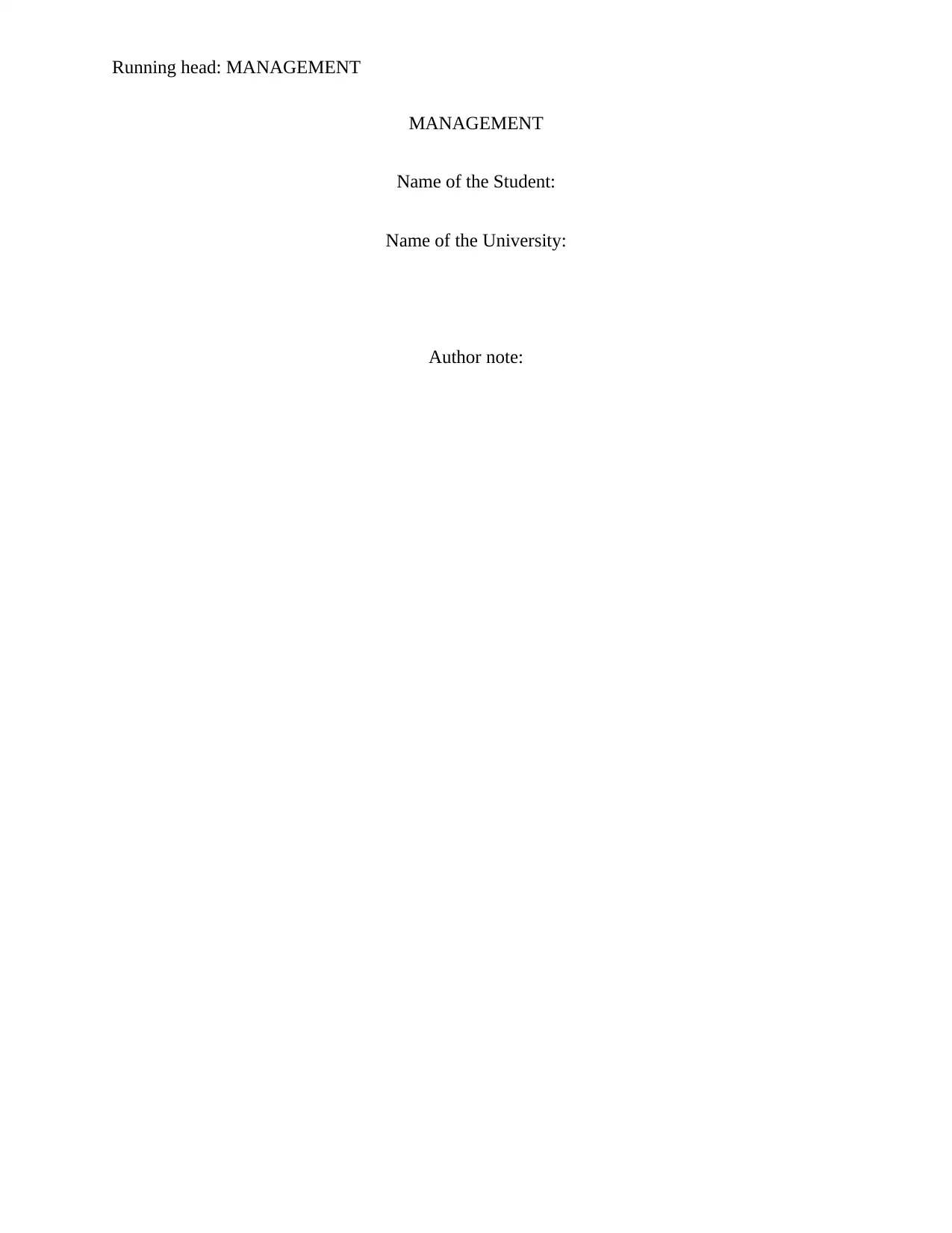
Running head: MANAGEMENT
MANAGEMENT
Name of the Student:
Name of the University:
Author note:
MANAGEMENT
Name of the Student:
Name of the University:
Author note:
Secure Best Marks with AI Grader
Need help grading? Try our AI Grader for instant feedback on your assignments.
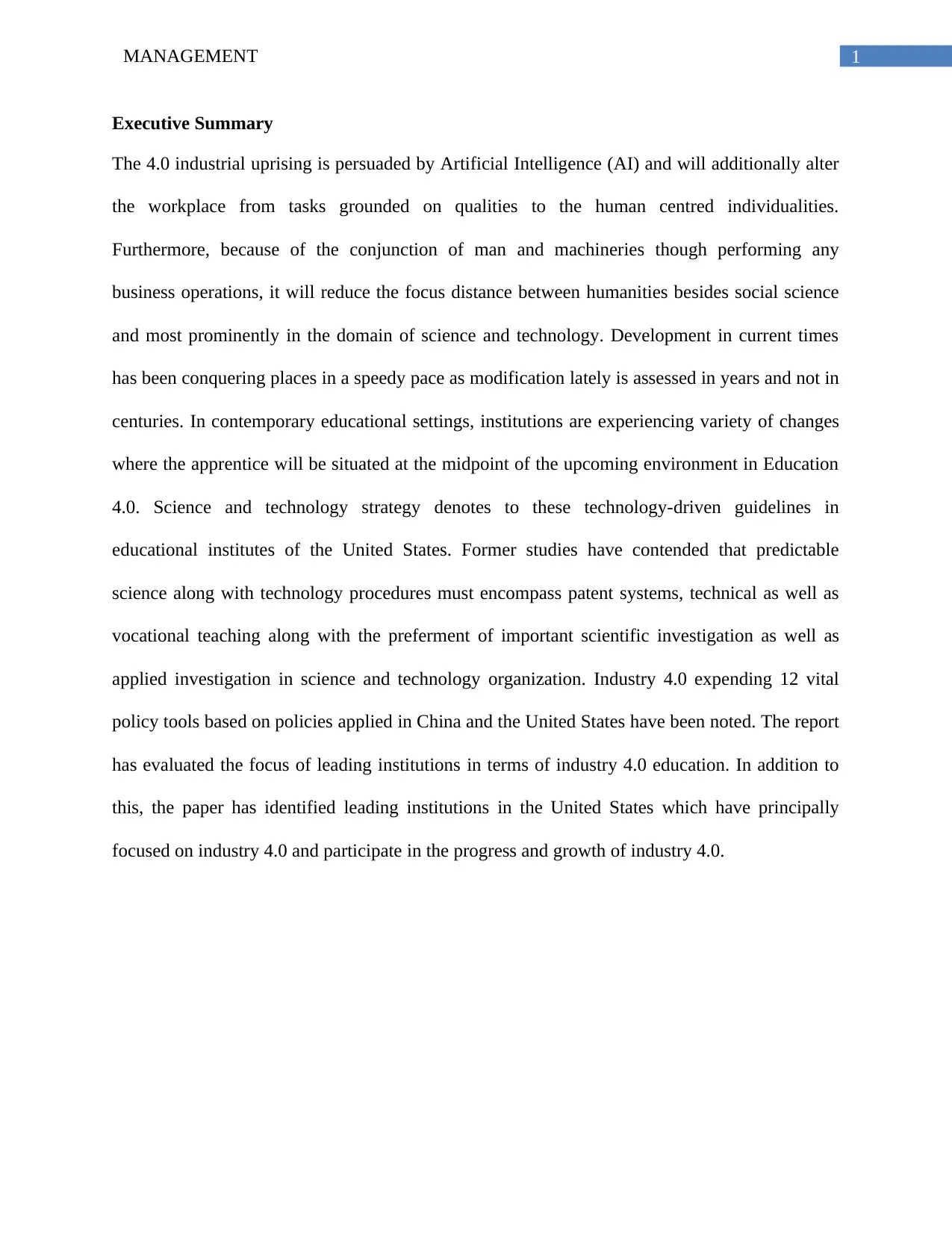
1MANAGEMENT
Executive Summary
The 4.0 industrial uprising is persuaded by Artificial Intelligence (AI) and will additionally alter
the workplace from tasks grounded on qualities to the human centred individualities.
Furthermore, because of the conjunction of man and machineries though performing any
business operations, it will reduce the focus distance between humanities besides social science
and most prominently in the domain of science and technology. Development in current times
has been conquering places in a speedy pace as modification lately is assessed in years and not in
centuries. In contemporary educational settings, institutions are experiencing variety of changes
where the apprentice will be situated at the midpoint of the upcoming environment in Education
4.0. Science and technology strategy denotes to these technology-driven guidelines in
educational institutes of the United States. Former studies have contended that predictable
science along with technology procedures must encompass patent systems, technical as well as
vocational teaching along with the preferment of important scientific investigation as well as
applied investigation in science and technology organization. Industry 4.0 expending 12 vital
policy tools based on policies applied in China and the United States have been noted. The report
has evaluated the focus of leading institutions in terms of industry 4.0 education. In addition to
this, the paper has identified leading institutions in the United States which have principally
focused on industry 4.0 and participate in the progress and growth of industry 4.0.
Executive Summary
The 4.0 industrial uprising is persuaded by Artificial Intelligence (AI) and will additionally alter
the workplace from tasks grounded on qualities to the human centred individualities.
Furthermore, because of the conjunction of man and machineries though performing any
business operations, it will reduce the focus distance between humanities besides social science
and most prominently in the domain of science and technology. Development in current times
has been conquering places in a speedy pace as modification lately is assessed in years and not in
centuries. In contemporary educational settings, institutions are experiencing variety of changes
where the apprentice will be situated at the midpoint of the upcoming environment in Education
4.0. Science and technology strategy denotes to these technology-driven guidelines in
educational institutes of the United States. Former studies have contended that predictable
science along with technology procedures must encompass patent systems, technical as well as
vocational teaching along with the preferment of important scientific investigation as well as
applied investigation in science and technology organization. Industry 4.0 expending 12 vital
policy tools based on policies applied in China and the United States have been noted. The report
has evaluated the focus of leading institutions in terms of industry 4.0 education. In addition to
this, the paper has identified leading institutions in the United States which have principally
focused on industry 4.0 and participate in the progress and growth of industry 4.0.
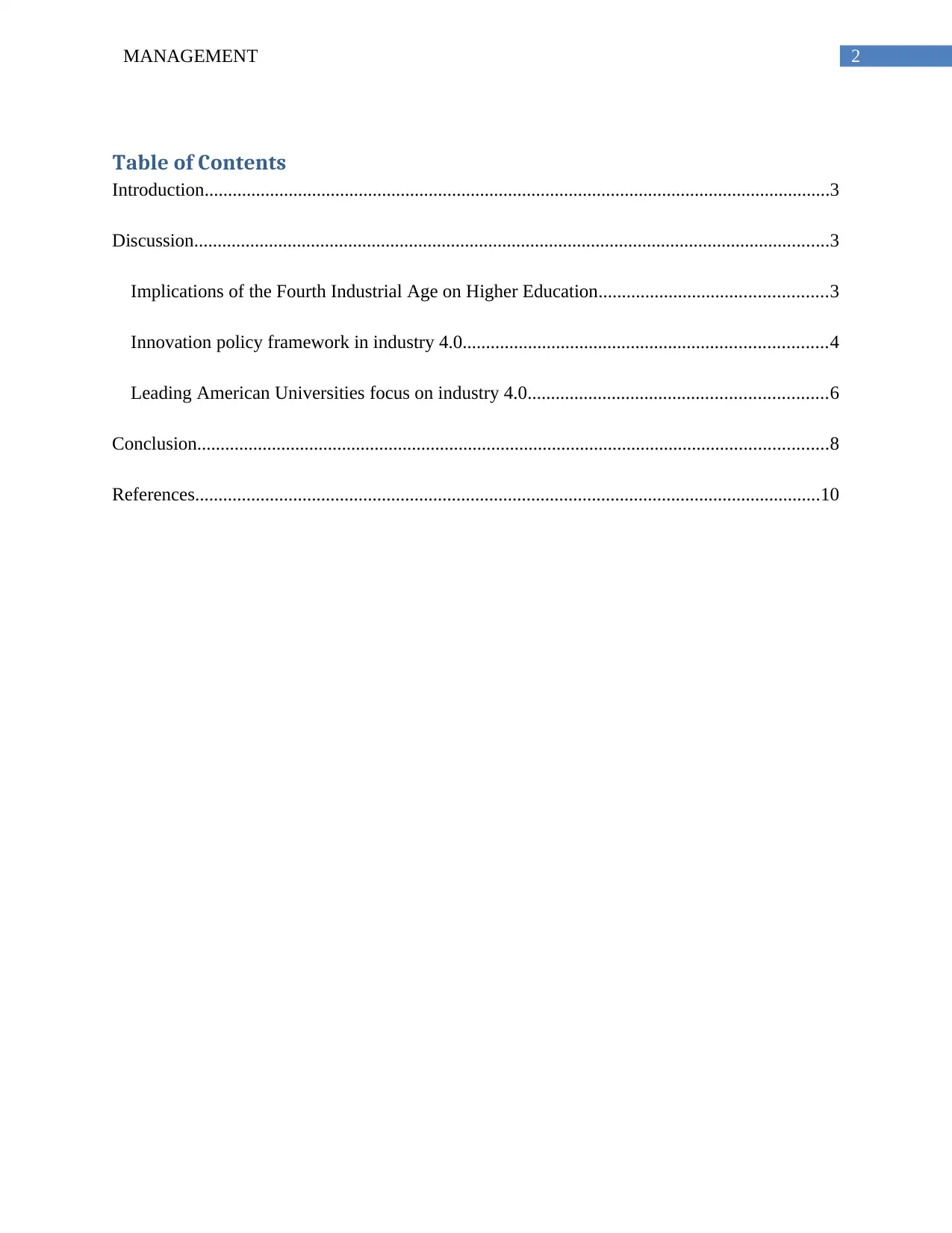
2MANAGEMENT
Table of Contents
Introduction......................................................................................................................................3
Discussion........................................................................................................................................3
Implications of the Fourth Industrial Age on Higher Education.................................................3
Innovation policy framework in industry 4.0..............................................................................4
Leading American Universities focus on industry 4.0................................................................6
Conclusion.......................................................................................................................................8
References......................................................................................................................................10
Table of Contents
Introduction......................................................................................................................................3
Discussion........................................................................................................................................3
Implications of the Fourth Industrial Age on Higher Education.................................................3
Innovation policy framework in industry 4.0..............................................................................4
Leading American Universities focus on industry 4.0................................................................6
Conclusion.......................................................................................................................................8
References......................................................................................................................................10
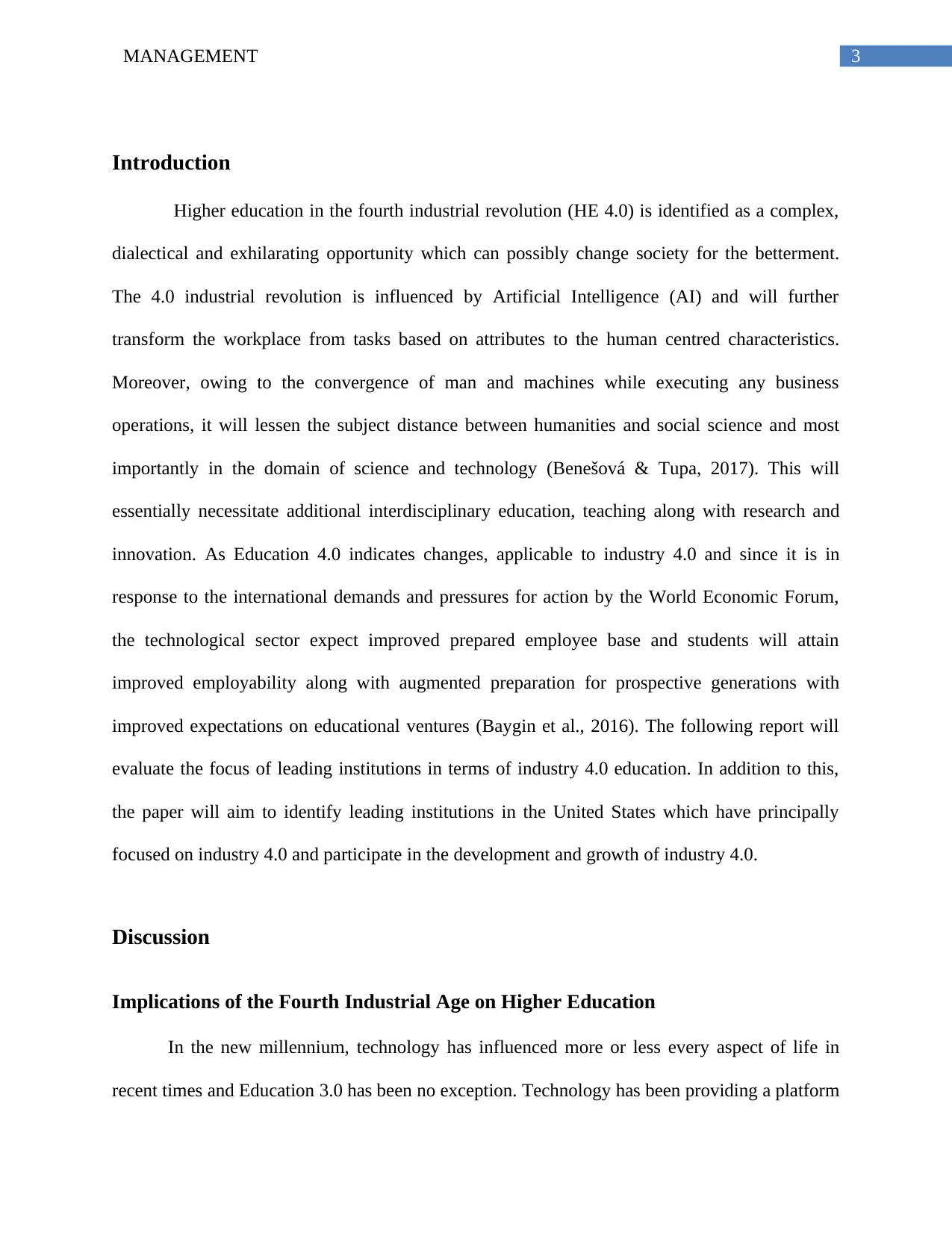
3MANAGEMENT
Introduction
Higher education in the fourth industrial revolution (HE 4.0) is identified as a complex,
dialectical and exhilarating opportunity which can possibly change society for the betterment.
The 4.0 industrial revolution is influenced by Artificial Intelligence (AI) and will further
transform the workplace from tasks based on attributes to the human centred characteristics.
Moreover, owing to the convergence of man and machines while executing any business
operations, it will lessen the subject distance between humanities and social science and most
importantly in the domain of science and technology (Benešová & Tupa, 2017). This will
essentially necessitate additional interdisciplinary education, teaching along with research and
innovation. As Education 4.0 indicates changes, applicable to industry 4.0 and since it is in
response to the international demands and pressures for action by the World Economic Forum,
the technological sector expect improved prepared employee base and students will attain
improved employability along with augmented preparation for prospective generations with
improved expectations on educational ventures (Baygin et al., 2016). The following report will
evaluate the focus of leading institutions in terms of industry 4.0 education. In addition to this,
the paper will aim to identify leading institutions in the United States which have principally
focused on industry 4.0 and participate in the development and growth of industry 4.0.
Discussion
Implications of the Fourth Industrial Age on Higher Education
In the new millennium, technology has influenced more or less every aspect of life in
recent times and Education 3.0 has been no exception. Technology has been providing a platform
Introduction
Higher education in the fourth industrial revolution (HE 4.0) is identified as a complex,
dialectical and exhilarating opportunity which can possibly change society for the betterment.
The 4.0 industrial revolution is influenced by Artificial Intelligence (AI) and will further
transform the workplace from tasks based on attributes to the human centred characteristics.
Moreover, owing to the convergence of man and machines while executing any business
operations, it will lessen the subject distance between humanities and social science and most
importantly in the domain of science and technology (Benešová & Tupa, 2017). This will
essentially necessitate additional interdisciplinary education, teaching along with research and
innovation. As Education 4.0 indicates changes, applicable to industry 4.0 and since it is in
response to the international demands and pressures for action by the World Economic Forum,
the technological sector expect improved prepared employee base and students will attain
improved employability along with augmented preparation for prospective generations with
improved expectations on educational ventures (Baygin et al., 2016). The following report will
evaluate the focus of leading institutions in terms of industry 4.0 education. In addition to this,
the paper will aim to identify leading institutions in the United States which have principally
focused on industry 4.0 and participate in the development and growth of industry 4.0.
Discussion
Implications of the Fourth Industrial Age on Higher Education
In the new millennium, technology has influenced more or less every aspect of life in
recent times and Education 3.0 has been no exception. Technology has been providing a platform
Secure Best Marks with AI Grader
Need help grading? Try our AI Grader for instant feedback on your assignments.
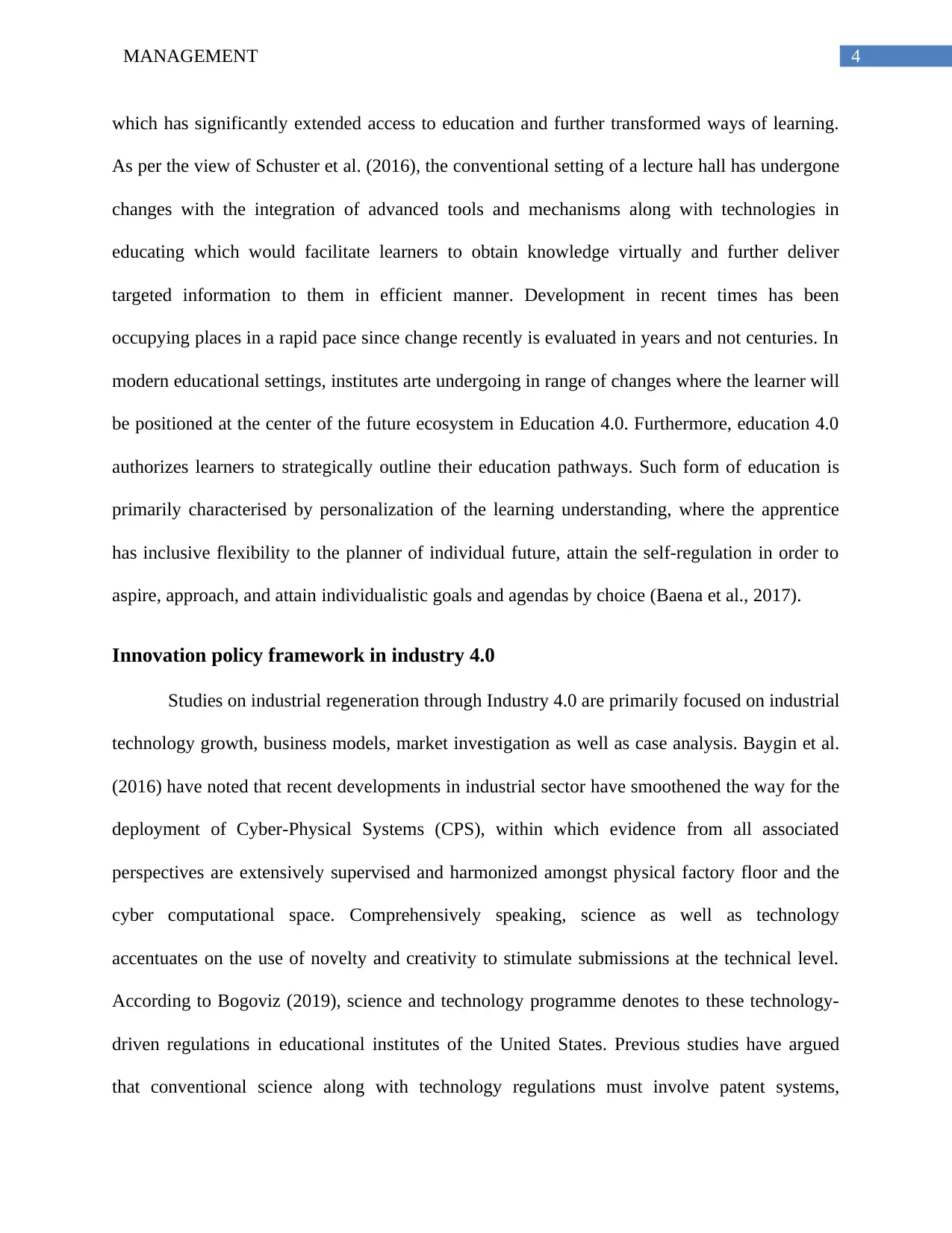
4MANAGEMENT
which has significantly extended access to education and further transformed ways of learning.
As per the view of Schuster et al. (2016), the conventional setting of a lecture hall has undergone
changes with the integration of advanced tools and mechanisms along with technologies in
educating which would facilitate learners to obtain knowledge virtually and further deliver
targeted information to them in efficient manner. Development in recent times has been
occupying places in a rapid pace since change recently is evaluated in years and not centuries. In
modern educational settings, institutes arte undergoing in range of changes where the learner will
be positioned at the center of the future ecosystem in Education 4.0. Furthermore, education 4.0
authorizes learners to strategically outline their education pathways. Such form of education is
primarily characterised by personalization of the learning understanding, where the apprentice
has inclusive flexibility to the planner of individual future, attain the self-regulation in order to
aspire, approach, and attain individualistic goals and agendas by choice (Baena et al., 2017).
Innovation policy framework in industry 4.0
Studies on industrial regeneration through Industry 4.0 are primarily focused on industrial
technology growth, business models, market investigation as well as case analysis. Baygin et al.
(2016) have noted that recent developments in industrial sector have smoothened the way for the
deployment of Cyber-Physical Systems (CPS), within which evidence from all associated
perspectives are extensively supervised and harmonized amongst physical factory floor and the
cyber computational space. Comprehensively speaking, science as well as technology
accentuates on the use of novelty and creativity to stimulate submissions at the technical level.
According to Bogoviz (2019), science and technology programme denotes to these technology-
driven regulations in educational institutes of the United States. Previous studies have argued
that conventional science along with technology regulations must involve patent systems,
which has significantly extended access to education and further transformed ways of learning.
As per the view of Schuster et al. (2016), the conventional setting of a lecture hall has undergone
changes with the integration of advanced tools and mechanisms along with technologies in
educating which would facilitate learners to obtain knowledge virtually and further deliver
targeted information to them in efficient manner. Development in recent times has been
occupying places in a rapid pace since change recently is evaluated in years and not centuries. In
modern educational settings, institutes arte undergoing in range of changes where the learner will
be positioned at the center of the future ecosystem in Education 4.0. Furthermore, education 4.0
authorizes learners to strategically outline their education pathways. Such form of education is
primarily characterised by personalization of the learning understanding, where the apprentice
has inclusive flexibility to the planner of individual future, attain the self-regulation in order to
aspire, approach, and attain individualistic goals and agendas by choice (Baena et al., 2017).
Innovation policy framework in industry 4.0
Studies on industrial regeneration through Industry 4.0 are primarily focused on industrial
technology growth, business models, market investigation as well as case analysis. Baygin et al.
(2016) have noted that recent developments in industrial sector have smoothened the way for the
deployment of Cyber-Physical Systems (CPS), within which evidence from all associated
perspectives are extensively supervised and harmonized amongst physical factory floor and the
cyber computational space. Comprehensively speaking, science as well as technology
accentuates on the use of novelty and creativity to stimulate submissions at the technical level.
According to Bogoviz (2019), science and technology programme denotes to these technology-
driven regulations in educational institutes of the United States. Previous studies have argued
that conventional science along with technology regulations must involve patent systems,
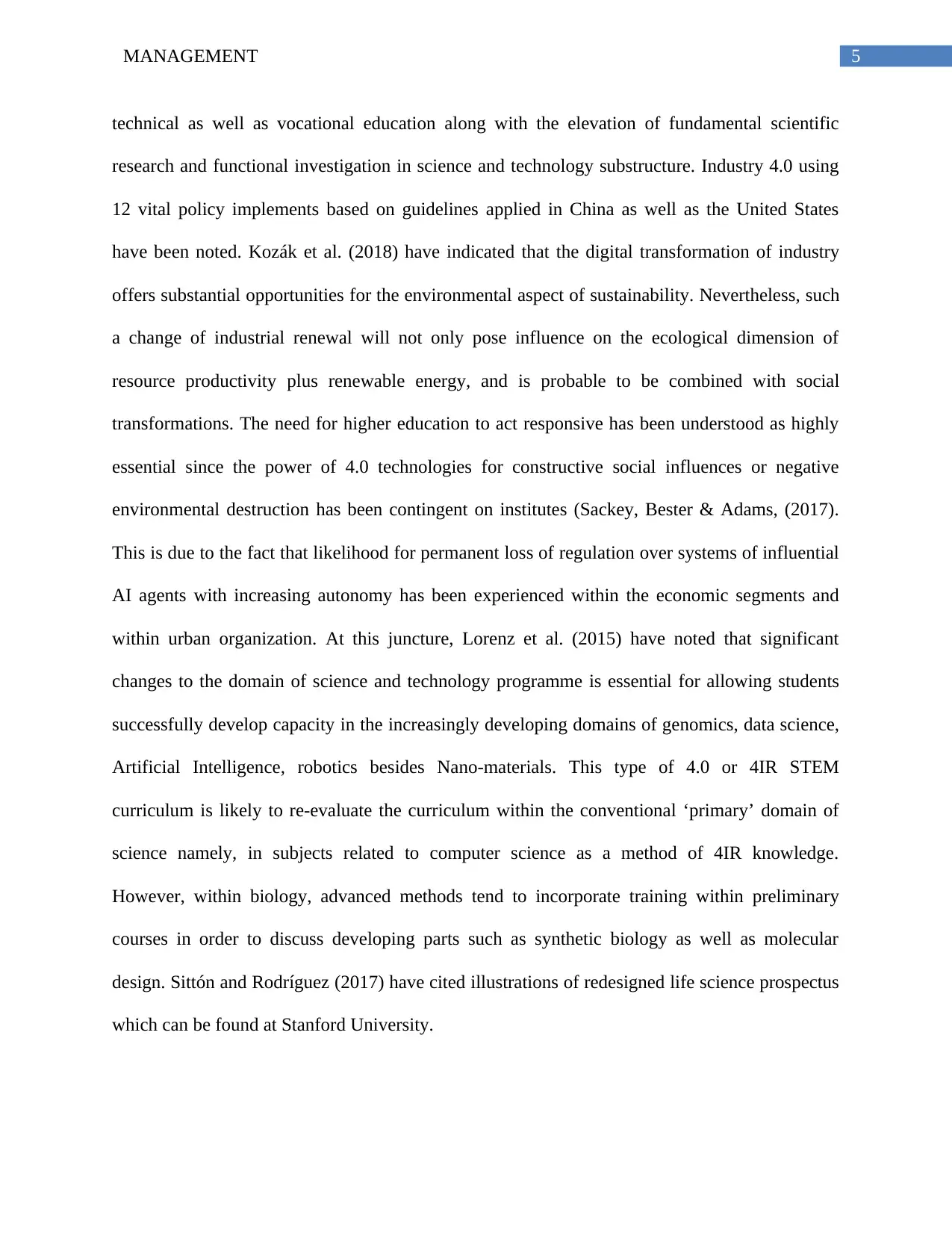
5MANAGEMENT
technical as well as vocational education along with the elevation of fundamental scientific
research and functional investigation in science and technology substructure. Industry 4.0 using
12 vital policy implements based on guidelines applied in China as well as the United States
have been noted. Kozák et al. (2018) have indicated that the digital transformation of industry
offers substantial opportunities for the environmental aspect of sustainability. Nevertheless, such
a change of industrial renewal will not only pose influence on the ecological dimension of
resource productivity plus renewable energy, and is probable to be combined with social
transformations. The need for higher education to act responsive has been understood as highly
essential since the power of 4.0 technologies for constructive social influences or negative
environmental destruction has been contingent on institutes (Sackey, Bester & Adams, (2017).
This is due to the fact that likelihood for permanent loss of regulation over systems of influential
AI agents with increasing autonomy has been experienced within the economic segments and
within urban organization. At this juncture, Lorenz et al. (2015) have noted that significant
changes to the domain of science and technology programme is essential for allowing students
successfully develop capacity in the increasingly developing domains of genomics, data science,
Artificial Intelligence, robotics besides Nano-materials. This type of 4.0 or 4IR STEM
curriculum is likely to re-evaluate the curriculum within the conventional ‘primary’ domain of
science namely, in subjects related to computer science as a method of 4IR knowledge.
However, within biology, advanced methods tend to incorporate training within preliminary
courses in order to discuss developing parts such as synthetic biology as well as molecular
design. Sittón and Rodríguez (2017) have cited illustrations of redesigned life science prospectus
which can be found at Stanford University.
technical as well as vocational education along with the elevation of fundamental scientific
research and functional investigation in science and technology substructure. Industry 4.0 using
12 vital policy implements based on guidelines applied in China as well as the United States
have been noted. Kozák et al. (2018) have indicated that the digital transformation of industry
offers substantial opportunities for the environmental aspect of sustainability. Nevertheless, such
a change of industrial renewal will not only pose influence on the ecological dimension of
resource productivity plus renewable energy, and is probable to be combined with social
transformations. The need for higher education to act responsive has been understood as highly
essential since the power of 4.0 technologies for constructive social influences or negative
environmental destruction has been contingent on institutes (Sackey, Bester & Adams, (2017).
This is due to the fact that likelihood for permanent loss of regulation over systems of influential
AI agents with increasing autonomy has been experienced within the economic segments and
within urban organization. At this juncture, Lorenz et al. (2015) have noted that significant
changes to the domain of science and technology programme is essential for allowing students
successfully develop capacity in the increasingly developing domains of genomics, data science,
Artificial Intelligence, robotics besides Nano-materials. This type of 4.0 or 4IR STEM
curriculum is likely to re-evaluate the curriculum within the conventional ‘primary’ domain of
science namely, in subjects related to computer science as a method of 4IR knowledge.
However, within biology, advanced methods tend to incorporate training within preliminary
courses in order to discuss developing parts such as synthetic biology as well as molecular
design. Sittón and Rodríguez (2017) have cited illustrations of redesigned life science prospectus
which can be found at Stanford University.
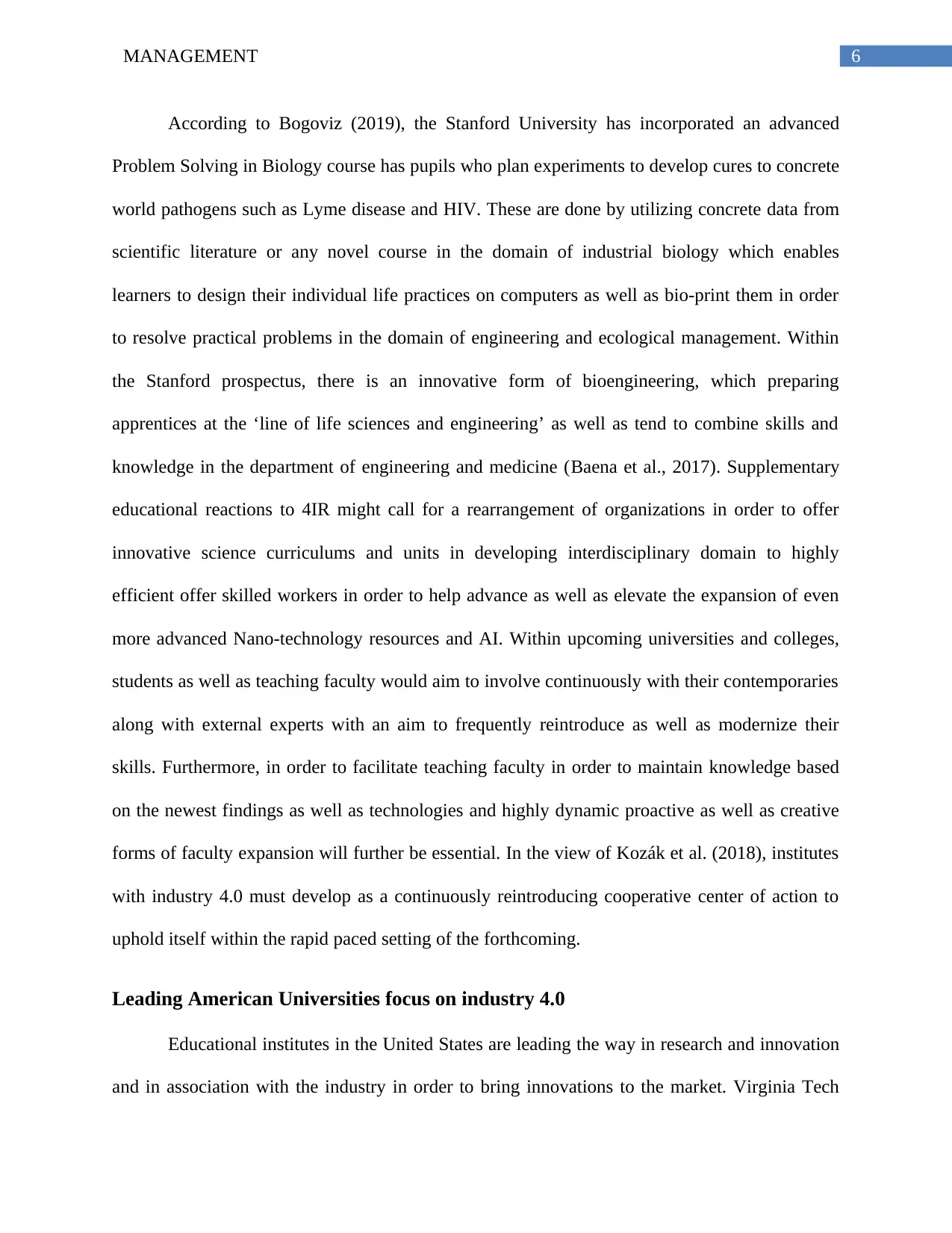
6MANAGEMENT
According to Bogoviz (2019), the Stanford University has incorporated an advanced
Problem Solving in Biology course has pupils who plan experiments to develop cures to concrete
world pathogens such as Lyme disease and HIV. These are done by utilizing concrete data from
scientific literature or any novel course in the domain of industrial biology which enables
learners to design their individual life practices on computers as well as bio-print them in order
to resolve practical problems in the domain of engineering and ecological management. Within
the Stanford prospectus, there is an innovative form of bioengineering, which preparing
apprentices at the ‘line of life sciences and engineering’ as well as tend to combine skills and
knowledge in the department of engineering and medicine (Baena et al., 2017). Supplementary
educational reactions to 4IR might call for a rearrangement of organizations in order to offer
innovative science curriculums and units in developing interdisciplinary domain to highly
efficient offer skilled workers in order to help advance as well as elevate the expansion of even
more advanced Nano-technology resources and AI. Within upcoming universities and colleges,
students as well as teaching faculty would aim to involve continuously with their contemporaries
along with external experts with an aim to frequently reintroduce as well as modernize their
skills. Furthermore, in order to facilitate teaching faculty in order to maintain knowledge based
on the newest findings as well as technologies and highly dynamic proactive as well as creative
forms of faculty expansion will further be essential. In the view of Kozák et al. (2018), institutes
with industry 4.0 must develop as a continuously reintroducing cooperative center of action to
uphold itself within the rapid paced setting of the forthcoming.
Leading American Universities focus on industry 4.0
Educational institutes in the United States are leading the way in research and innovation
and in association with the industry in order to bring innovations to the market. Virginia Tech
According to Bogoviz (2019), the Stanford University has incorporated an advanced
Problem Solving in Biology course has pupils who plan experiments to develop cures to concrete
world pathogens such as Lyme disease and HIV. These are done by utilizing concrete data from
scientific literature or any novel course in the domain of industrial biology which enables
learners to design their individual life practices on computers as well as bio-print them in order
to resolve practical problems in the domain of engineering and ecological management. Within
the Stanford prospectus, there is an innovative form of bioengineering, which preparing
apprentices at the ‘line of life sciences and engineering’ as well as tend to combine skills and
knowledge in the department of engineering and medicine (Baena et al., 2017). Supplementary
educational reactions to 4IR might call for a rearrangement of organizations in order to offer
innovative science curriculums and units in developing interdisciplinary domain to highly
efficient offer skilled workers in order to help advance as well as elevate the expansion of even
more advanced Nano-technology resources and AI. Within upcoming universities and colleges,
students as well as teaching faculty would aim to involve continuously with their contemporaries
along with external experts with an aim to frequently reintroduce as well as modernize their
skills. Furthermore, in order to facilitate teaching faculty in order to maintain knowledge based
on the newest findings as well as technologies and highly dynamic proactive as well as creative
forms of faculty expansion will further be essential. In the view of Kozák et al. (2018), institutes
with industry 4.0 must develop as a continuously reintroducing cooperative center of action to
uphold itself within the rapid paced setting of the forthcoming.
Leading American Universities focus on industry 4.0
Educational institutes in the United States are leading the way in research and innovation
and in association with the industry in order to bring innovations to the market. Virginia Tech
Paraphrase This Document
Need a fresh take? Get an instant paraphrase of this document with our AI Paraphraser
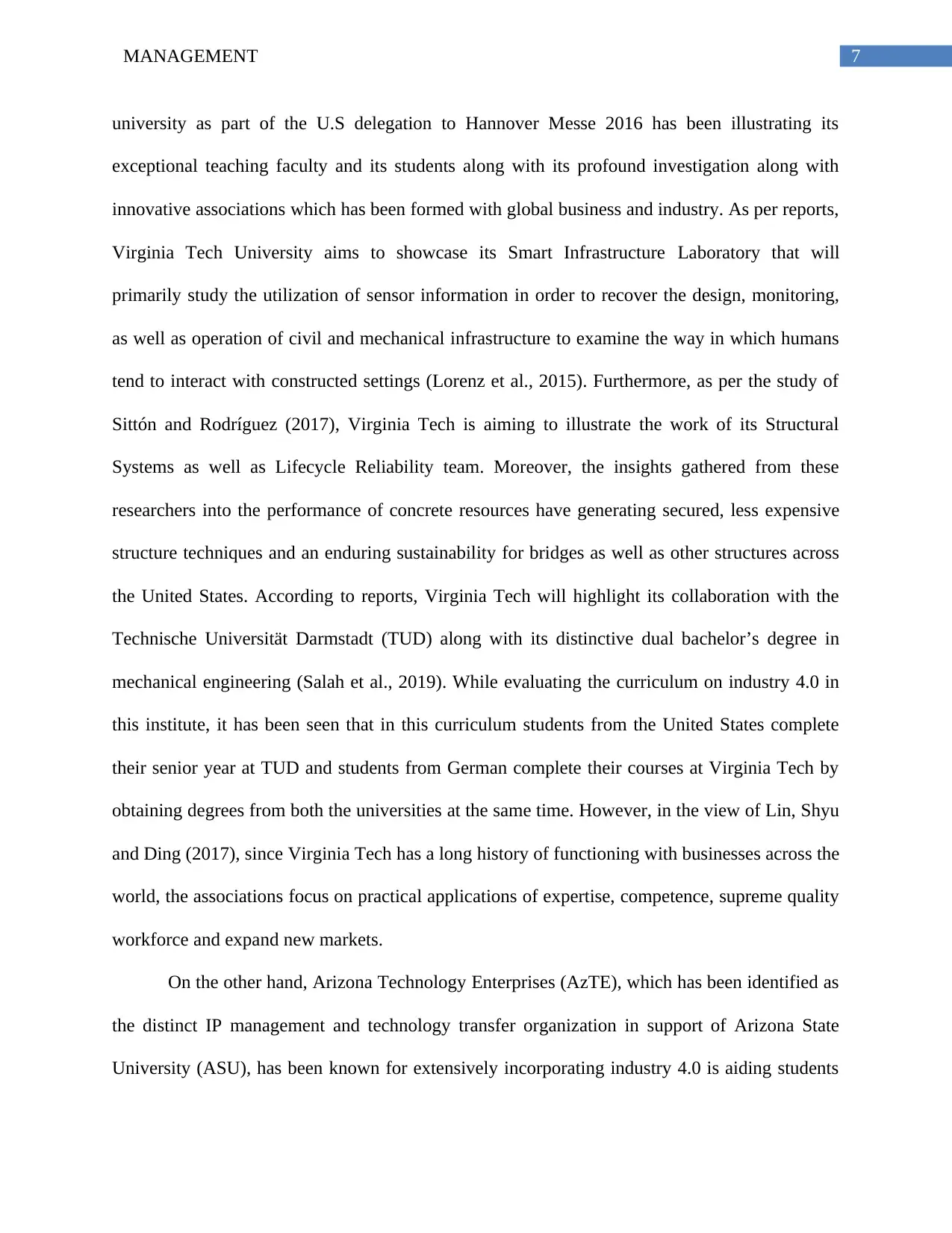
7MANAGEMENT
university as part of the U.S delegation to Hannover Messe 2016 has been illustrating its
exceptional teaching faculty and its students along with its profound investigation along with
innovative associations which has been formed with global business and industry. As per reports,
Virginia Tech University aims to showcase its Smart Infrastructure Laboratory that will
primarily study the utilization of sensor information in order to recover the design, monitoring,
as well as operation of civil and mechanical infrastructure to examine the way in which humans
tend to interact with constructed settings (Lorenz et al., 2015). Furthermore, as per the study of
Sittón and Rodríguez (2017), Virginia Tech is aiming to illustrate the work of its Structural
Systems as well as Lifecycle Reliability team. Moreover, the insights gathered from these
researchers into the performance of concrete resources have generating secured, less expensive
structure techniques and an enduring sustainability for bridges as well as other structures across
the United States. According to reports, Virginia Tech will highlight its collaboration with the
Technische Universität Darmstadt (TUD) along with its distinctive dual bachelor’s degree in
mechanical engineering (Salah et al., 2019). While evaluating the curriculum on industry 4.0 in
this institute, it has been seen that in this curriculum students from the United States complete
their senior year at TUD and students from German complete their courses at Virginia Tech by
obtaining degrees from both the universities at the same time. However, in the view of Lin, Shyu
and Ding (2017), since Virginia Tech has a long history of functioning with businesses across the
world, the associations focus on practical applications of expertise, competence, supreme quality
workforce and expand new markets.
On the other hand, Arizona Technology Enterprises (AzTE), which has been identified as
the distinct IP management and technology transfer organization in support of Arizona State
University (ASU), has been known for extensively incorporating industry 4.0 is aiding students
university as part of the U.S delegation to Hannover Messe 2016 has been illustrating its
exceptional teaching faculty and its students along with its profound investigation along with
innovative associations which has been formed with global business and industry. As per reports,
Virginia Tech University aims to showcase its Smart Infrastructure Laboratory that will
primarily study the utilization of sensor information in order to recover the design, monitoring,
as well as operation of civil and mechanical infrastructure to examine the way in which humans
tend to interact with constructed settings (Lorenz et al., 2015). Furthermore, as per the study of
Sittón and Rodríguez (2017), Virginia Tech is aiming to illustrate the work of its Structural
Systems as well as Lifecycle Reliability team. Moreover, the insights gathered from these
researchers into the performance of concrete resources have generating secured, less expensive
structure techniques and an enduring sustainability for bridges as well as other structures across
the United States. According to reports, Virginia Tech will highlight its collaboration with the
Technische Universität Darmstadt (TUD) along with its distinctive dual bachelor’s degree in
mechanical engineering (Salah et al., 2019). While evaluating the curriculum on industry 4.0 in
this institute, it has been seen that in this curriculum students from the United States complete
their senior year at TUD and students from German complete their courses at Virginia Tech by
obtaining degrees from both the universities at the same time. However, in the view of Lin, Shyu
and Ding (2017), since Virginia Tech has a long history of functioning with businesses across the
world, the associations focus on practical applications of expertise, competence, supreme quality
workforce and expand new markets.
On the other hand, Arizona Technology Enterprises (AzTE), which has been identified as
the distinct IP management and technology transfer organization in support of Arizona State
University (ASU), has been known for extensively incorporating industry 4.0 is aiding students
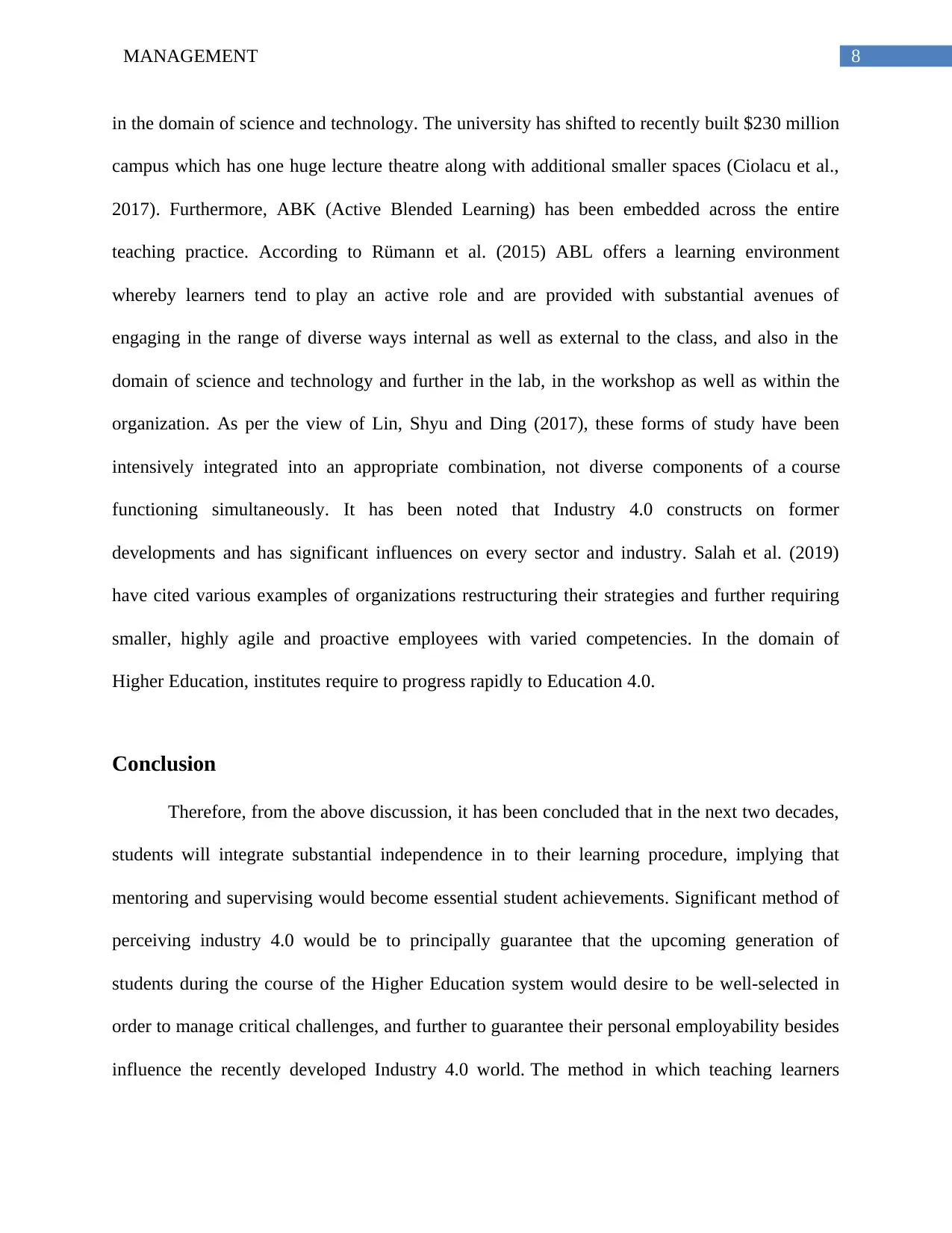
8MANAGEMENT
in the domain of science and technology. The university has shifted to recently built $230 million
campus which has one huge lecture theatre along with additional smaller spaces (Ciolacu et al.,
2017). Furthermore, ABK (Active Blended Learning) has been embedded across the entire
teaching practice. According to Rümann et al. (2015) ABL offers a learning environment
whereby learners tend to play an active role and are provided with substantial avenues of
engaging in the range of diverse ways internal as well as external to the class, and also in the
domain of science and technology and further in the lab, in the workshop as well as within the
organization. As per the view of Lin, Shyu and Ding (2017), these forms of study have been
intensively integrated into an appropriate combination, not diverse components of a course
functioning simultaneously. It has been noted that Industry 4.0 constructs on former
developments and has significant influences on every sector and industry. Salah et al. (2019)
have cited various examples of organizations restructuring their strategies and further requiring
smaller, highly agile and proactive employees with varied competencies. In the domain of
Higher Education, institutes require to progress rapidly to Education 4.0.
Conclusion
Therefore, from the above discussion, it has been concluded that in the next two decades,
students will integrate substantial independence in to their learning procedure, implying that
mentoring and supervising would become essential student achievements. Significant method of
perceiving industry 4.0 would be to principally guarantee that the upcoming generation of
students during the course of the Higher Education system would desire to be well-selected in
order to manage critical challenges, and further to guarantee their personal employability besides
influence the recently developed Industry 4.0 world. The method in which teaching learners
in the domain of science and technology. The university has shifted to recently built $230 million
campus which has one huge lecture theatre along with additional smaller spaces (Ciolacu et al.,
2017). Furthermore, ABK (Active Blended Learning) has been embedded across the entire
teaching practice. According to Rümann et al. (2015) ABL offers a learning environment
whereby learners tend to play an active role and are provided with substantial avenues of
engaging in the range of diverse ways internal as well as external to the class, and also in the
domain of science and technology and further in the lab, in the workshop as well as within the
organization. As per the view of Lin, Shyu and Ding (2017), these forms of study have been
intensively integrated into an appropriate combination, not diverse components of a course
functioning simultaneously. It has been noted that Industry 4.0 constructs on former
developments and has significant influences on every sector and industry. Salah et al. (2019)
have cited various examples of organizations restructuring their strategies and further requiring
smaller, highly agile and proactive employees with varied competencies. In the domain of
Higher Education, institutes require to progress rapidly to Education 4.0.
Conclusion
Therefore, from the above discussion, it has been concluded that in the next two decades,
students will integrate substantial independence in to their learning procedure, implying that
mentoring and supervising would become essential student achievements. Significant method of
perceiving industry 4.0 would be to principally guarantee that the upcoming generation of
students during the course of the Higher Education system would desire to be well-selected in
order to manage critical challenges, and further to guarantee their personal employability besides
influence the recently developed Industry 4.0 world. The method in which teaching learners
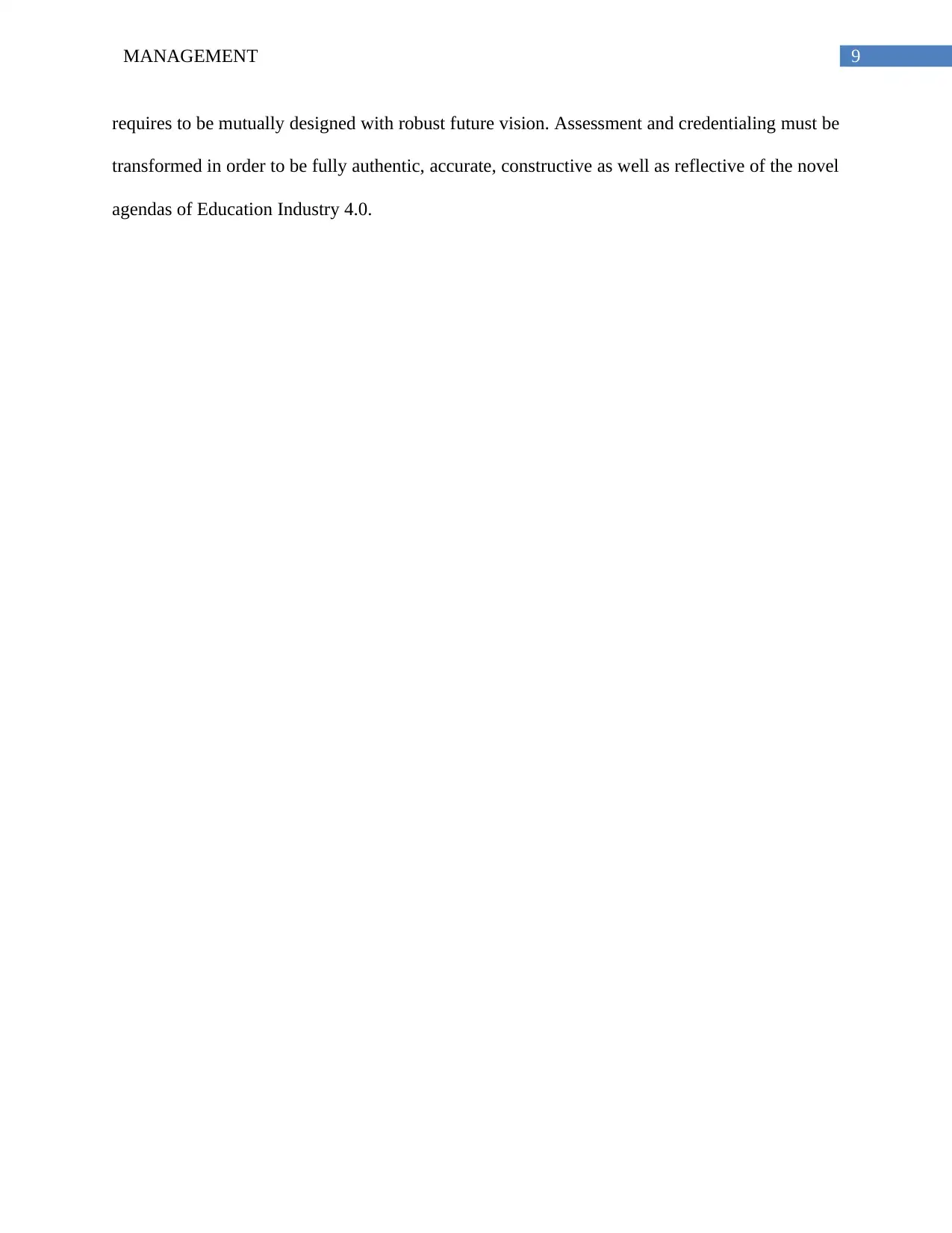
9MANAGEMENT
requires to be mutually designed with robust future vision. Assessment and credentialing must be
transformed in order to be fully authentic, accurate, constructive as well as reflective of the novel
agendas of Education Industry 4.0.
requires to be mutually designed with robust future vision. Assessment and credentialing must be
transformed in order to be fully authentic, accurate, constructive as well as reflective of the novel
agendas of Education Industry 4.0.
Secure Best Marks with AI Grader
Need help grading? Try our AI Grader for instant feedback on your assignments.
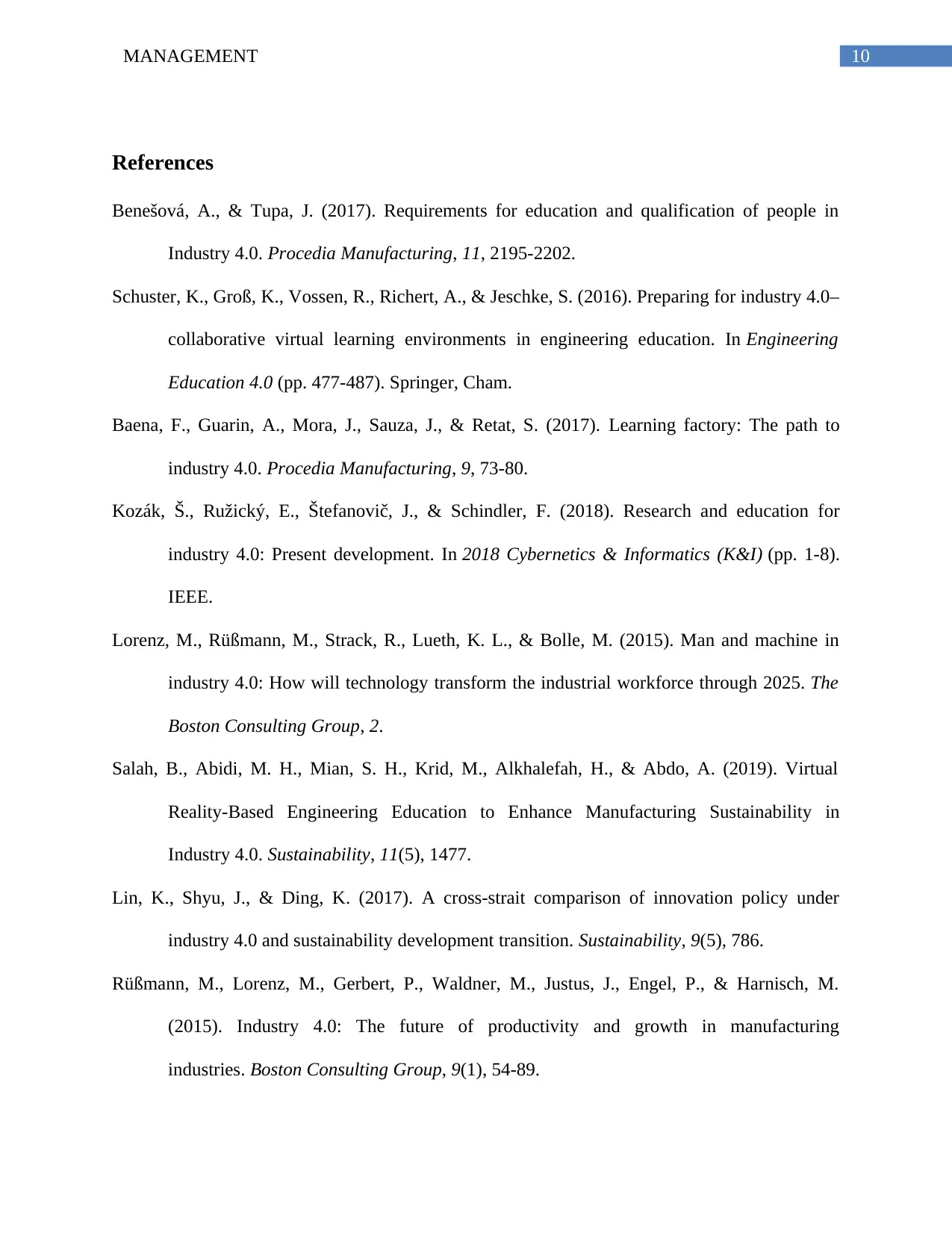
10MANAGEMENT
References
Benešová, A., & Tupa, J. (2017). Requirements for education and qualification of people in
Industry 4.0. Procedia Manufacturing, 11, 2195-2202.
Schuster, K., Groß, K., Vossen, R., Richert, A., & Jeschke, S. (2016). Preparing for industry 4.0–
collaborative virtual learning environments in engineering education. In Engineering
Education 4.0 (pp. 477-487). Springer, Cham.
Baena, F., Guarin, A., Mora, J., Sauza, J., & Retat, S. (2017). Learning factory: The path to
industry 4.0. Procedia Manufacturing, 9, 73-80.
Kozák, Š., Ružický, E., Štefanovič, J., & Schindler, F. (2018). Research and education for
industry 4.0: Present development. In 2018 Cybernetics & Informatics (K&I) (pp. 1-8).
IEEE.
Lorenz, M., Rüßmann, M., Strack, R., Lueth, K. L., & Bolle, M. (2015). Man and machine in
industry 4.0: How will technology transform the industrial workforce through 2025. The
Boston Consulting Group, 2.
Salah, B., Abidi, M. H., Mian, S. H., Krid, M., Alkhalefah, H., & Abdo, A. (2019). Virtual
Reality-Based Engineering Education to Enhance Manufacturing Sustainability in
Industry 4.0. Sustainability, 11(5), 1477.
Lin, K., Shyu, J., & Ding, K. (2017). A cross-strait comparison of innovation policy under
industry 4.0 and sustainability development transition. Sustainability, 9(5), 786.
Rüßmann, M., Lorenz, M., Gerbert, P., Waldner, M., Justus, J., Engel, P., & Harnisch, M.
(2015). Industry 4.0: The future of productivity and growth in manufacturing
industries. Boston Consulting Group, 9(1), 54-89.
References
Benešová, A., & Tupa, J. (2017). Requirements for education and qualification of people in
Industry 4.0. Procedia Manufacturing, 11, 2195-2202.
Schuster, K., Groß, K., Vossen, R., Richert, A., & Jeschke, S. (2016). Preparing for industry 4.0–
collaborative virtual learning environments in engineering education. In Engineering
Education 4.0 (pp. 477-487). Springer, Cham.
Baena, F., Guarin, A., Mora, J., Sauza, J., & Retat, S. (2017). Learning factory: The path to
industry 4.0. Procedia Manufacturing, 9, 73-80.
Kozák, Š., Ružický, E., Štefanovič, J., & Schindler, F. (2018). Research and education for
industry 4.0: Present development. In 2018 Cybernetics & Informatics (K&I) (pp. 1-8).
IEEE.
Lorenz, M., Rüßmann, M., Strack, R., Lueth, K. L., & Bolle, M. (2015). Man and machine in
industry 4.0: How will technology transform the industrial workforce through 2025. The
Boston Consulting Group, 2.
Salah, B., Abidi, M. H., Mian, S. H., Krid, M., Alkhalefah, H., & Abdo, A. (2019). Virtual
Reality-Based Engineering Education to Enhance Manufacturing Sustainability in
Industry 4.0. Sustainability, 11(5), 1477.
Lin, K., Shyu, J., & Ding, K. (2017). A cross-strait comparison of innovation policy under
industry 4.0 and sustainability development transition. Sustainability, 9(5), 786.
Rüßmann, M., Lorenz, M., Gerbert, P., Waldner, M., Justus, J., Engel, P., & Harnisch, M.
(2015). Industry 4.0: The future of productivity and growth in manufacturing
industries. Boston Consulting Group, 9(1), 54-89.
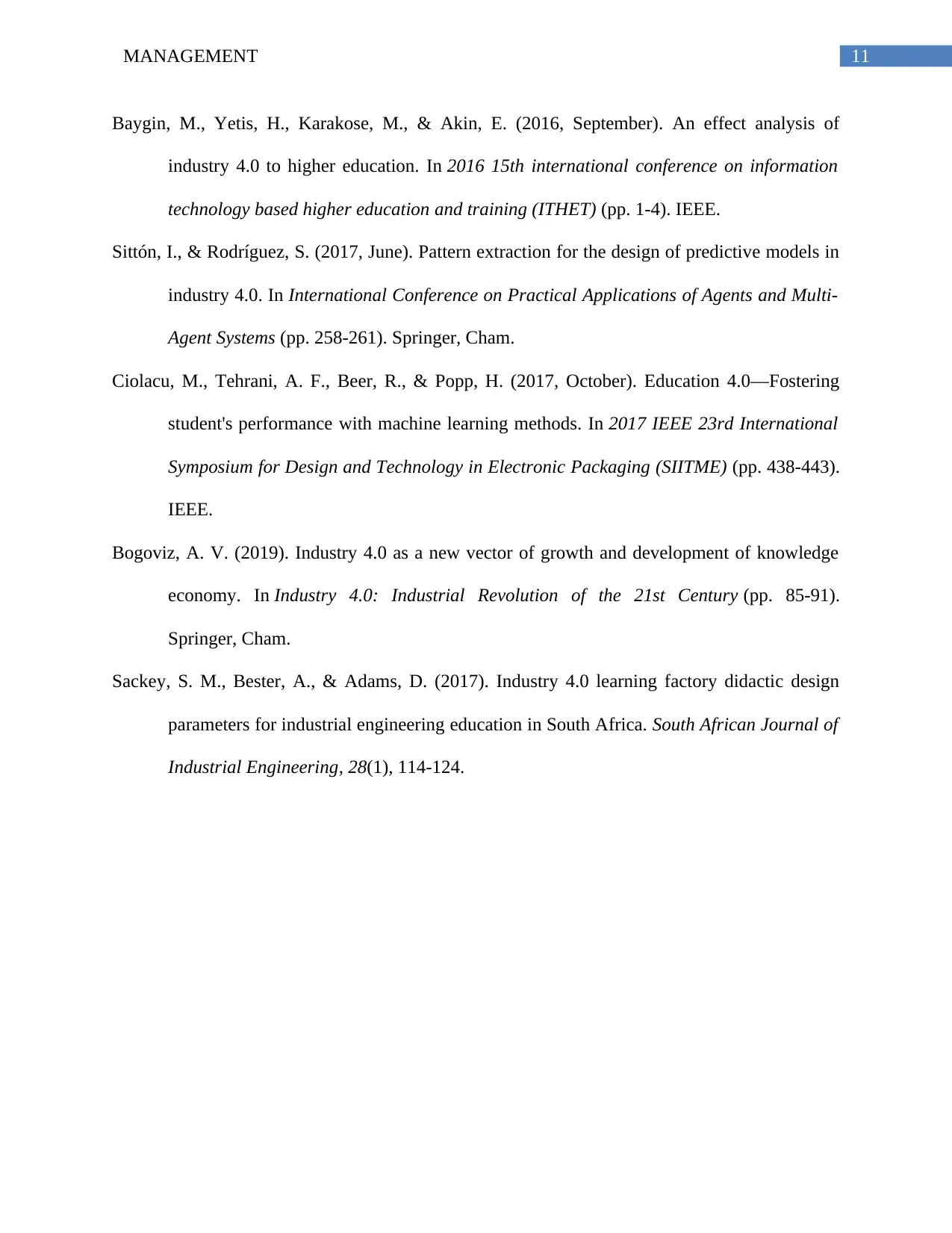
11MANAGEMENT
Baygin, M., Yetis, H., Karakose, M., & Akin, E. (2016, September). An effect analysis of
industry 4.0 to higher education. In 2016 15th international conference on information
technology based higher education and training (ITHET) (pp. 1-4). IEEE.
Sittón, I., & Rodríguez, S. (2017, June). Pattern extraction for the design of predictive models in
industry 4.0. In International Conference on Practical Applications of Agents and Multi-
Agent Systems (pp. 258-261). Springer, Cham.
Ciolacu, M., Tehrani, A. F., Beer, R., & Popp, H. (2017, October). Education 4.0—Fostering
student's performance with machine learning methods. In 2017 IEEE 23rd International
Symposium for Design and Technology in Electronic Packaging (SIITME) (pp. 438-443).
IEEE.
Bogoviz, A. V. (2019). Industry 4.0 as a new vector of growth and development of knowledge
economy. In Industry 4.0: Industrial Revolution of the 21st Century (pp. 85-91).
Springer, Cham.
Sackey, S. M., Bester, A., & Adams, D. (2017). Industry 4.0 learning factory didactic design
parameters for industrial engineering education in South Africa. South African Journal of
Industrial Engineering, 28(1), 114-124.
Baygin, M., Yetis, H., Karakose, M., & Akin, E. (2016, September). An effect analysis of
industry 4.0 to higher education. In 2016 15th international conference on information
technology based higher education and training (ITHET) (pp. 1-4). IEEE.
Sittón, I., & Rodríguez, S. (2017, June). Pattern extraction for the design of predictive models in
industry 4.0. In International Conference on Practical Applications of Agents and Multi-
Agent Systems (pp. 258-261). Springer, Cham.
Ciolacu, M., Tehrani, A. F., Beer, R., & Popp, H. (2017, October). Education 4.0—Fostering
student's performance with machine learning methods. In 2017 IEEE 23rd International
Symposium for Design and Technology in Electronic Packaging (SIITME) (pp. 438-443).
IEEE.
Bogoviz, A. V. (2019). Industry 4.0 as a new vector of growth and development of knowledge
economy. In Industry 4.0: Industrial Revolution of the 21st Century (pp. 85-91).
Springer, Cham.
Sackey, S. M., Bester, A., & Adams, D. (2017). Industry 4.0 learning factory didactic design
parameters for industrial engineering education in South Africa. South African Journal of
Industrial Engineering, 28(1), 114-124.
1 out of 12
Related Documents
Your All-in-One AI-Powered Toolkit for Academic Success.
+13062052269
info@desklib.com
Available 24*7 on WhatsApp / Email
![[object Object]](/_next/static/media/star-bottom.7253800d.svg)
Unlock your academic potential
© 2024 | Zucol Services PVT LTD | All rights reserved.





